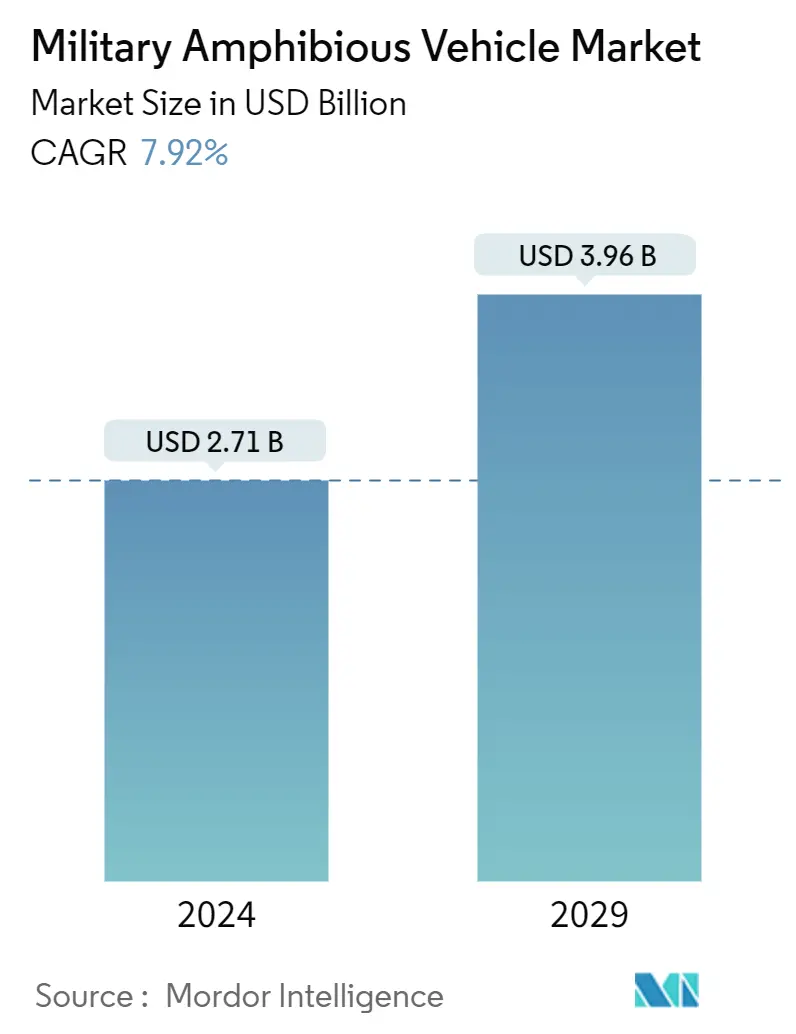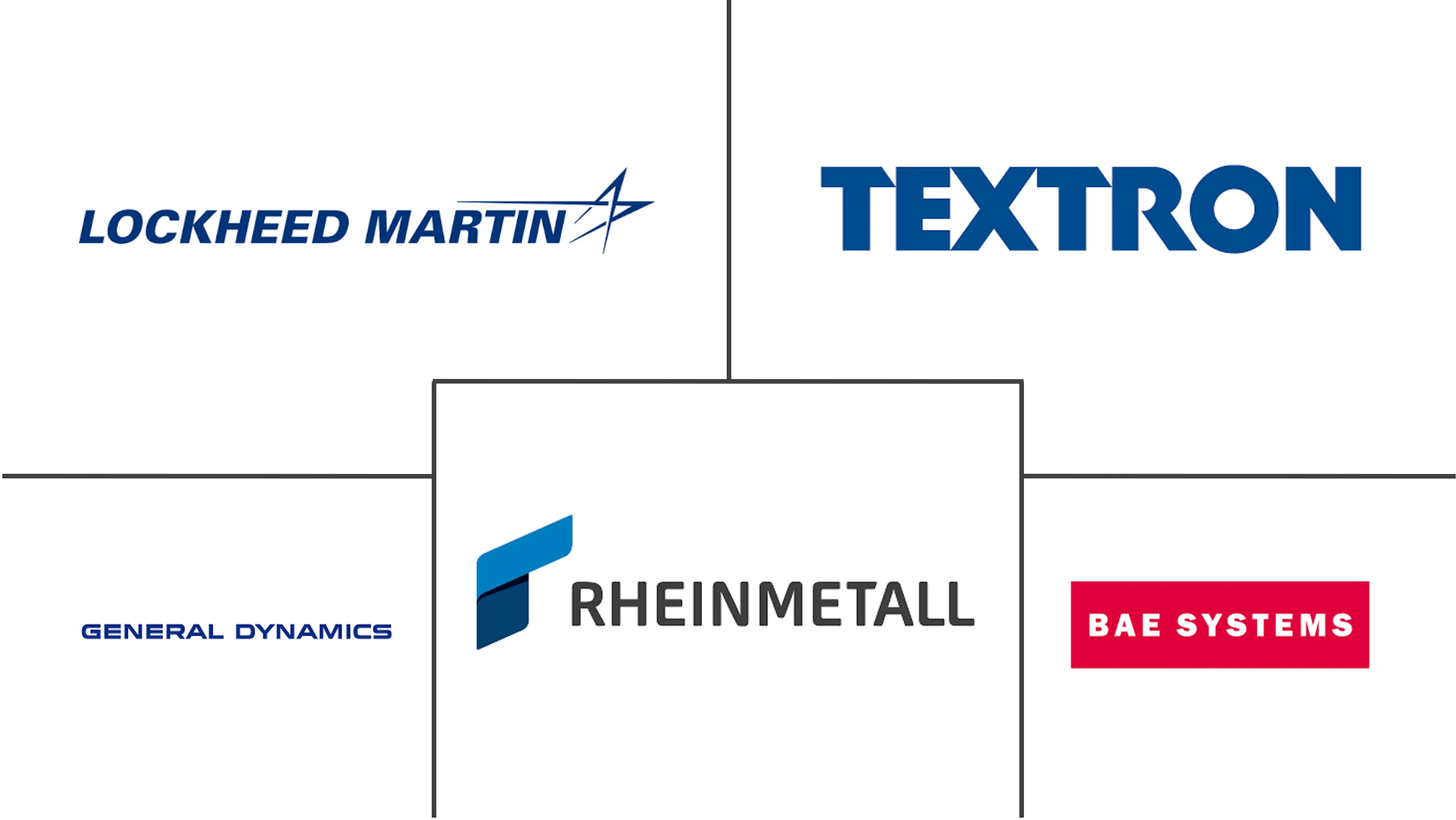Market Size of Military Amphibious Vehicle Industry

| Study Period | 2019-2029 |
| Market Size (2024) | USD 2.71 Billion |
| Market Size (2029) | USD 3.96 Billion |
| CAGR (2024 - 2029) | 7.92 % |
| Fastest Growing Market | North America |
| Largest Market | North America |
| Market Concentration | High |
Major Players
*Disclaimer: Major Players sorted in no particular order |
Military Amphibious Vehicle Market Analysis
The Military Amphibious Vehicle Market size is estimated at USD 2.71 billion in 2024, and is expected to reach USD 3.96 billion by 2029, growing at a CAGR of 7.92% during the forecast period (2024-2029).
The increase in defense budgets, especially in emerging economies, drives the global market for amphibious vehicles. As territorial disputes are increasing all over the world, nations are now focusing on enhancing their military capabilities. An increase in defense expenditures and the rising necessity to perform military search and rescue, assault, and combat support operations in shallow waters are the main drivers for the market studied. The growing global emphasis on securing maritime borders and ensuring coastal defense has fuelled the demand for military amphibious vehicles. These versatile vehicles offer strategic advantages by enabling rapid deployment and maneuverability across both land and water, addressing the evolving security challenges in coastal regions.
Ongoing advancements in technology, including amphibious vehicle design, propulsion systems, and materials, are driving the growth of the market studied. Innovations such as enhanced amphibious capabilities, improved speed, and increased payload capacities contribute to the modernization of military fleets, fostering the adoption of these vehicles by defense forces worldwide. Many armed forces worldwide are undertaking modernization programs to enhance their capabilities. As part of these initiatives, there is a growing emphasis on acquiring technologically advanced and versatile equipment, including amphibious vehicles. However, factors such as their limited operability, the requirement of time-to-time maintenance of the amphibious vehicles, the high cost of maintenance, etc., are projected to challenge the growth of the market studied during the forecast period.
Military Amphibious Vehicle Industry Segmentation
An amphibious vehicle is a means of transport viable on land as well as on water. Amphibious armored vehicles and hovercraft are the two types of amphibious vehicles that are covered in the study. Their applications include, but are not limited to, combat, patrol, surveillance and reconnaissance, and search and rescue operations.
The military amphibious vehicle market is segmented by type and geography. By type, the market is segmented into amphibious armored vehicles and hovercraft. The report also covers the market sizes and forecasts in 11 countries across major regions, such as North America, Europe, Asia-Pacific, Latin America, and Middle East and Africa. The report offers the market size in value terms in USD for all the abovementioned segments.
| Type | |
| Amphibious Armored Vehicles | |
| Hovercraft |
| Geography | |||||||
| |||||||
| |||||||
| |||||||
| |||||||
|
Military Amphibious Vehicle Market Size Summary
The military amphibious vehicle market is poised for significant growth, driven by increasing defense budgets and the need for enhanced military capabilities in response to global territorial disputes. The demand for these versatile vehicles is fueled by the necessity to conduct military operations in shallow waters, including search and rescue, assault, and combat support missions. The emphasis on securing maritime borders and coastal defense has further propelled the market, as amphibious vehicles offer strategic advantages such as rapid deployment and maneuverability across land and water. Technological advancements in vehicle design, propulsion systems, and materials are contributing to the modernization of military fleets, with a focus on acquiring advanced and versatile equipment. Despite challenges such as limited operability and high maintenance costs, the market is expected to expand, with amphibious armored vehicles dominating due to their advanced armor and seamless transition capabilities between terrains.
North America is anticipated to lead the market growth, supported by increased defense spending and geopolitical tensions necessitating rapid response capabilities. The United States is heavily investing in modernizing its amphibious capabilities, with programs like the Amphibious Combat Vehicle (ACV) aimed at replacing older models. The market is characterized by a few key players holding significant shares, with companies like BAE Systems PLC, General Dynamics Corporation, and Lockheed Martin Corporation at the forefront. These players are leveraging technological innovations and continuous research and development to capture opportunities in developing next-generation amphibious vehicles. The market's consolidated nature and the presence of regional players catering to specific demands underscore the competitive dynamics, with product performance, reliability, and cost-effectiveness being crucial factors. Long-term programs and large-scale contracts are pivotal for sustained growth, as evidenced by recent contracts and acquisitions in various regions.
Military Amphibious Vehicle Market Size - Table of Contents
-
1. MARKET DYNAMICS
-
1.1 Market Overview
-
1.2 Market Drivers
-
1.3 Market Restraints
-
1.4 Porter's Five Forces Analysis
-
1.4.1 Threat of New Entrants
-
1.4.2 Bargaining Power of Buyers/Consumers
-
1.4.3 Bargaining Power of Suppliers
-
1.4.4 Threat of Substitute Products
-
1.4.5 Intensity of Competitive Rivalry
-
-
-
2. MARKET SEGMENTATION
-
2.1 Type
-
2.1.1 Amphibious Armored Vehicles
-
2.1.2 Hovercraft
-
-
2.2 Geography
-
2.2.1 North America
-
2.2.1.1 North America
-
2.2.1.2 Canada
-
-
2.2.2 Europe
-
2.2.2.1 United Kingdom
-
2.2.2.2 Germany
-
2.2.2.3 France
-
2.2.2.4 Russia
-
2.2.2.5 Rest of Europe
-
-
2.2.3 Asia-Pacific
-
2.2.3.1 China
-
2.2.3.2 India
-
2.2.3.3 Japan
-
2.2.3.4 South Korea
-
2.2.3.5 Rest of Asia-Pacific
-
-
2.2.4 Latin America
-
2.2.4.1 Brazil
-
2.2.4.2 Mexico
-
2.2.4.3 Rest of Latin America
-
-
2.2.5 Middle East and Africa
-
2.2.5.1 United Arab Emirates
-
2.2.5.2 Saudi Arabia
-
2.2.5.3 Qatar
-
2.2.5.4 South Africa
-
2.2.5.5 Rest of Middle East and Africa
-
-
-
Military Amphibious Vehicle Market Size FAQs
How big is the Military Amphibious Vehicle Market?
The Military Amphibious Vehicle Market size is expected to reach USD 2.71 billion in 2024 and grow at a CAGR of 7.92% to reach USD 3.96 billion by 2029.
What is the current Military Amphibious Vehicle Market size?
In 2024, the Military Amphibious Vehicle Market size is expected to reach USD 2.71 billion.

